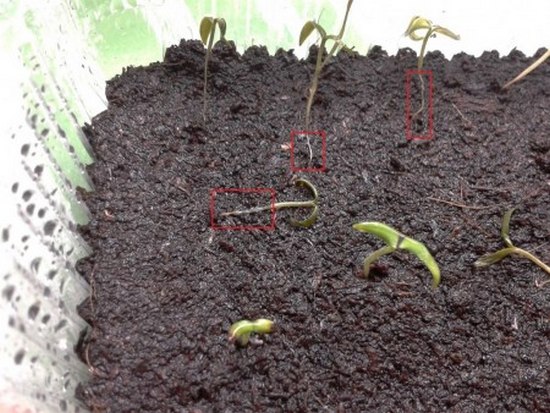The causative agents of blackleg are always present in the soil. Why then do some summer residents’ seedlings “fall”, while others grow healthy? The fact is that the former create favorable conditions for the development of fungal infection, and the latter - for plants.
|
This is what seedlings affected by blackleg look like |
Preparations for sowing on the windowsill begin by preparing soil for seedlings in the fall (not in the garden), good compost, humus (they should be homogeneous, without organic residues). All this, scattered into bags (preferably small ones), is left in the cold so that all components of the future seedling mixture are disinfected by frost.
In the spring, all you have to do is water the soil mixture before sowing with a weak solution of manganese. Although you can do without it. In recent years, before sowing, many summer residents spill the soil with a solution of biological fungicides (for example, phytosporin M), soak the seeds in it before sowing.
These and other precautions help reduce the likelihood of infection, but do not guarantee complete safety. Therefore, it is very important to create conditions for the development of seedlings, and not pathogenic spores.
How to protect seedlings from blackleg
- There is no rush to sow seeds. February crops always lack light, plant roots freeze on cold window sills, leaves are dried by hot air rising from radiators. Such weakened seedlings are easy prey for blackleg. The microclimate can be improved by equipping additional lighting, placing wooden blocks under boxes or cassette boxes, and covering the batteries with damp thick material.
- The black leg feels at ease in thickened crops. Therefore, even if you have a lot of seeds (you collected them yourself), do not sow them in a bunch. It is better to sow in cassettes in which the plants are isolated from each other from the very beginning. The blackleg, even if it reveals itself, in such conditions is less likely to affect the entire seedling. Ventilate the seedlings more often.
- It is advisable to sprinkle the surface of the soil in the seedling box or cassettes with sand and wood ash. Proper watering is very important. You can't water the seedlings little by little, but often...In this case, the soil surface is wet almost all the time and favorable conditions are created for the development of the disease. With rare but abundant watering, the soil in the root zone of the seedlings remains moist for a long time, and its surface quickly dries out.
When watering seedlings, you need to try to keep the plant stems dry.
What to do if the black leg still begins to mow down the seedlings?
- Immediately remove diseased plants without waiting for them to fall off.
- Water the soil with a weak solution of potassium permanganate, add fresh soil mixture, and dust it with wood ash.
- It is advisable to transplant healthy plants from the container where the first blackleg diseased seedlings appeared, deepening the stems to the cotyledon leaves.
- Maintain a moderate temperature (18 - 20º)
- Don't forget to loosen the soil in the seedling box.
Continuation of the topic:


 CUCUMBERS NEVER GET SICK, I'VE BEEN USING ONLY THIS FOR 40 YEARS! I SHARE A SECRET WITH YOU, CUCUMBERS ARE LIKE THE PICTURE!
CUCUMBERS NEVER GET SICK, I'VE BEEN USING ONLY THIS FOR 40 YEARS! I SHARE A SECRET WITH YOU, CUCUMBERS ARE LIKE THE PICTURE! You can dig a bucket of potatoes from each bush. Do you think these are fairy tales? Watch the video
You can dig a bucket of potatoes from each bush. Do you think these are fairy tales? Watch the video
 How our fellow gardeners work in Korea. There is a lot to learn and just fun to watch.
How our fellow gardeners work in Korea. There is a lot to learn and just fun to watch. Eye trainer. The author claims that with daily viewing, vision is restored. They don't charge money for views.
Eye trainer. The author claims that with daily viewing, vision is restored. They don't charge money for views. A 3-ingredient cake recipe in 30 minutes is better than Napoleon. Simple and very tasty.
A 3-ingredient cake recipe in 30 minutes is better than Napoleon. Simple and very tasty. Therapeutic exercises for cervical osteochondrosis. A complete set of exercises.
Therapeutic exercises for cervical osteochondrosis. A complete set of exercises. Which indoor plants match your zodiac sign?
Which indoor plants match your zodiac sign? What about them? Excursion to German dachas.
What about them? Excursion to German dachas.